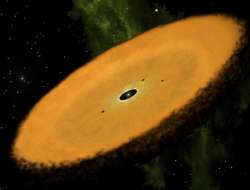Scientists discover oldest known planetary disk
A gathering of stargazers believe to have discovered an oldest known planet-shaping disk - a 45-million-year-old ring of gas and tidy that circles around a young star. Circumstellar disks around red dwarfs like this one

A gathering of stargazers believe to have discovered an oldest known planet-shaping disk - a 45-million-year-old ring of gas and tidy that circles around a young star.
Circumstellar disks around red dwarfs like this one are rare to begin with, but this star, called AWI0005x3s, appears to have sustained its disk for an exceptionally long time, according to the study published in The Astrophysical Journal Letters.
"Most disks of this kind fade away in less than 30 million years," said lead researcher Steven Silverberg from University of Oklahoma in the US.
"This particular red dwarf is a candidate member of the Carina stellar association, which would make it around 45 million years old (like the rest of the stars in that group). It's the oldest red dwarf system with a disk we've seen in one of these associations," Silverberg noted.
The discovery relied on citizen scientists from Disk Detective, a project led by NASA's Goddard Space Flight Center's Marc Kuchner that is designed to find new circumstellar disks.
"Without the help of the citizen scientists examining these objects and finding the good ones, we might never have spotted this object," Kuchner said.
"It is surprising to see a circumstellar disk around a star that may be 45 million years old, because we normally expect these disks to dissipate within a few million years," one of the researchers Jonathan Gagne from Carnegie Institution for Science said.
"More observations will be needed to determine whether the star is really as old as we suspect, and if it turns out to be, it will certainly become a benchmark system to understand the lifetime of disks," Gagne noted.
This star and its disk are also interesting because of the possibility that it could host extrasolar planets, the study said.
(With inputs from IANS)